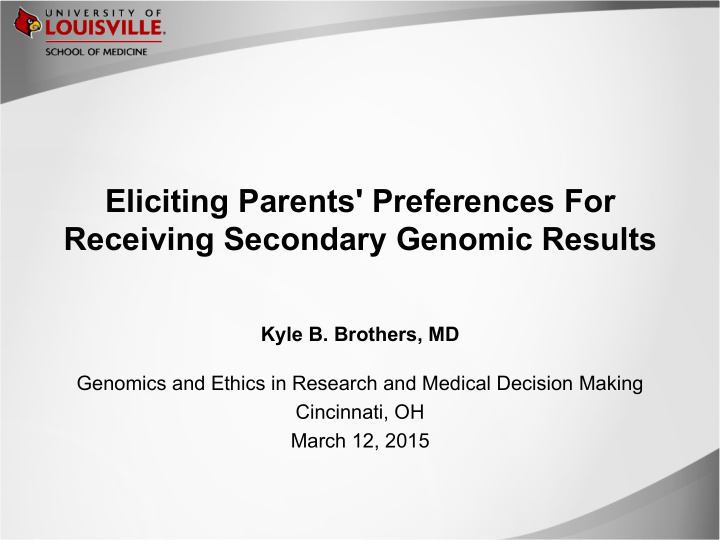



Eliciting Parents' Preferences For Receiving Secondary Genomic Results Kyle B. Brothers, MD Genomics and Ethics in Research and Medical Decision Making Cincinnati, OH March 12, 2015
Outline • Framework – Focus groups on clinical pharmacogenomics • Novel Preferences Instrument – Genomic Results Patient Preferences Questionnaire • Experience in the Field – Parents preferences from our CSER Project
Framework
Focus Groups Findings • With respect to secondary findings: – Important to respect preferences – If I do not know, doctor should not know
Filtering Based on Preferences Analysis Provider Patient Conclusion 1: Preferences should be applied at the level of analysis. Therefore, they must be structured.
PREDICT Focus Groups (2011) Everything Everything - 1 Nothing
PREDICT Focus Groups (2011) Everything Everything - 1 Nothing “My best friend’s mother has Alzheimer’s. She has chosen to not have that genetic testing.” “If that genetic testing was offered today, and my mother has [Alzheimer’s], I don’t want to know.”
PREDICT Focus Groups (2011) Everything Everything - 1 Nothing Conclusion 2: Patients should be able to record preferences that result from personal experience with specific conditions.
Novel Preferences Instrument
Genomic Results Patient Preferences Questionnaire
Genomic Results Patient Preferences Questionnaire 14 questions
GRPPQ • Cardiovascular Disorders • Neurodegenerative Disorders • Mental Illness • Cancer • Carrier Status/Heritable Risk
Experience in the Field
Genomic Diagnosis in Children with Developmental Delay Karyotype 3-5% Microarray 15-20% Next-Generation Sequencing ?
Project 3 Hypotheses • Collecting preferences at enrollment will increase perceived control and decrease anxiety (Clinical Trial) • GRPPQ will adequately capture parents’ preferences • GRPPQ preferences can be used to infer parents’ other preferences
Clinical Trial Design Informed Consent, Baseline Questionnaire Enrollment Randomize Visit GC & Preferences GC Only 50% 50% Return of Results Preferences and Return of Results ROR Visit Follow-Up Questionnaire
Table 1 Group 1 Group 2 (Preferences at Enrollment) (Preferences at ROR) 62 (50%) 24 (50%) Mothers 62 (50%) 24 (50%) Fathers 99 (80%) 42 (88%) White 8 (6%) 0 (0%) Black/African-American Other 17 (14%) 6 (12%) 19 (15%) 2 (4%) 20's 51 (41%) 15 (31%) 30's 28 (23%) 22 (46%) 40's 24 (19%) 9 (19%) ≥50
Preferences By Group
Preferences By Gender
Preferences By Category
Preferences By Category
Qualitative Findings • Parents report that the GRPPQ captures their preferences. • Most parents understand questionnaire, but misunderstandings do occur • Eliciting preferences can create assumption that we are looking for listed conditions, and that such analysis would be meaningful
Thank You! HudsonAlpha CSER Team KCPCRU • Rick Myers (PI) • Carla Rich • Greg Cooper • Jan Sullivan • Greg Barsch • Sarah Penny • Ed Lose • Kimberly Blair • Martina Bebin • Kevin Bowling • Elizabeth Newton • Shirley Simmons
Recommend
More recommend